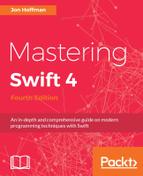While watching the presentations from WWDC 2015 about protocol extensions and protocol-oriented programming (POP), I will admit that I was very skeptical. I have worked with object-oriented programming (OOP) for so long that I was unsure whether this new programming paradigm would solve all of the problems that Apple was claiming it would. Since I am not one who lets my skepticism get in the way of trying something new, I set up a new project that mirrored the one I was currently working on, but wrote the code using Apple's recommendations for POP. I also used protocol extensions extensively in the code. I can honestly say that I was amazed at how much cleaner the new project was compared to the original one. I believe that protocol extensions are going to be one of those defining features that set one programming language apart from the rest. I also believe that many major languages will soon have similar features.
In this chapter, you will learn about the following topics:
- How are protocols used as a type?
- How do we implement polymorphism in Swift using protocols?
- How do we use protocol extensions?
- Why we would want to use protocol extensions?
While protocol extensions are basically syntactic sugar, they are, in my opinion, one of the most important additions to the Swift programming language. With protocol extensions, we are able to provide method and property implementations to any type that conforms to a protocol. To really understand how useful protocols and protocol extensions are, let's get a better understanding of protocols.
While classes, structures, and enumerations can all conform to protocols in Swift, for this chapter, we will be focusing on classes and structures. Enumerations are used when we need to represent a finite number of cases, and while there are valid use cases where we would have an enumeration conform to a protocol, they are very rare in my experience. Just remember that anywhere we refer to a class or structure, we can also use an enumeration.
Let's begin exploring protocols by seeing how they are full-fledged types in Swift.
